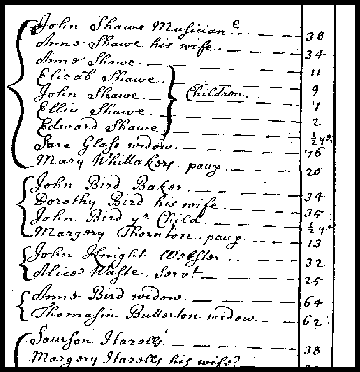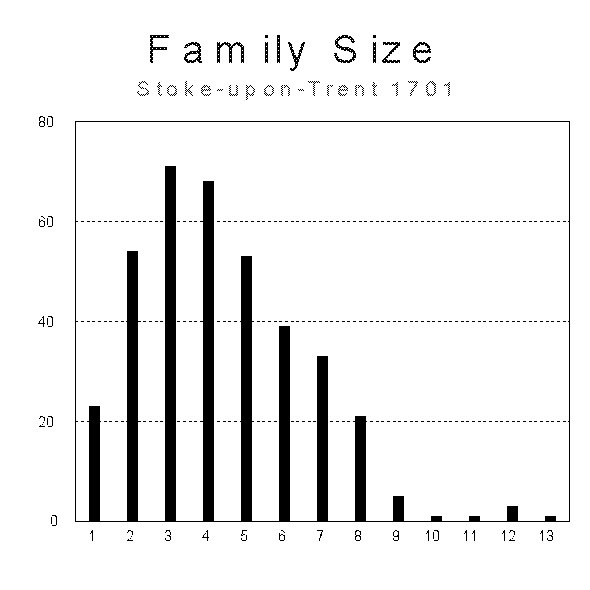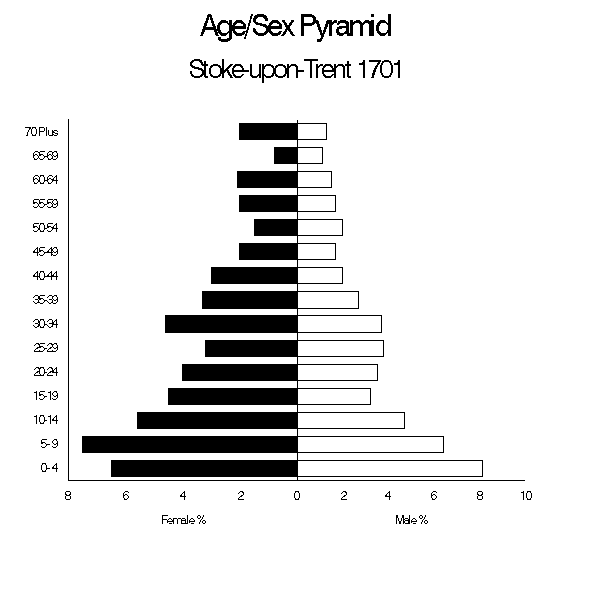
|
|
The Stoke-upon-Trent Parish Listing of 1701

Introduction
As is well known the first national census which recorded the names of people nation-wide was that of 1841. What is less well known is that similar, but less detailed, lists of each individual residing in particular communities in earlier years were occasionally drawn up for a variety of reasons. One such listing, dated the 2nd June 1701, exists for Stoke-upon-Trent.
Format of the Listing
The Stoke-upon-Trent listing is dated the 2nd June 1701. It is written on the first 40 pages of a 72-page quarto paper booklet. The listing begins with the date and a brief description at the beginning of the area included and the format of the entries.
2nd June 1701
A collection of the names of every particular and individual person in the parish of Stoke-upon-Trent, in the County of Stafford, as they are now residing within their respective Liberties and Families within the said parish; together with the age of every such person, as near as can conveniently be known, as also the number of families and souls qualified (as to their ages) for communicating, in each family.
In the listing families are arranged according to liberty (or township). Families, consisting of two or more persons, are numbered in sequence. Persons living alone are not numbered but they are listed in sequence between families. The information recorded for most people is as follows: their full names, their relationship to the first person listed in each family and their ages. Additional information is also given for some individuals relating to their occupations, illegitimacy and aliases. Finally, the number of communicants residing in each family is shown. Figure 1 shows household PE17 in the format given by the listing: the family consists of Elizabeth Hatton, widow, her two children Jane and Elizabeth and two illegitimate grandchildren Abigail and William. There were three communicants in the family.
Figure 1: Penkhull Household 17 (PE17)
|
Elizabeth Hatton |
Widow |
64 |
3 Com |
|
Jane Hatton ) |
Children |
31
|
|
|
Elizabeth Hatton ) |
|
20 |
|
|
Abigail Hatton ) |
Spurious |
5 |
|
|
William Hatton ) |
Jane's children |
2 Wks |
|
All families in the six liberties of Penkhull, Clayton, Seabridge, Shelton, Hanley and Fenton Culvert are presented in sequence. The following page (41) is headed 'Fenton Vivian' but no families are shown and the listing comes to an abrupt end.
Who Undertook the Listing
The listing was prepared by or on behalf of Thomas Allen, who was rector of Stoke from 1697 to 1732. Thomas Allen was a local man, who was young at the time of his appointment, and seems to have been active and able. Although Thomas Allen was probably the person who inspired this information-gathering activity the work of sorting out and writing up the listing was evidently left to his curate, John Ward, and the parish clerk, John Poulson. At the time of the listing they were living together, with a female servant (Margaret Elkin) and the aged Michael Ward, who was almost certainly the curate's father. Poulson, the parish clerk, wrote out the listing. His occupation is recorded in the listing, and the handwriting of the listing is that of the register at the time.
Why the Listing was Compiled
What motivated Allen to have the parish listing compiled is a mystery, but it should be noted that Allen was particularly methodical in recording details of his parishioners. The parish registers which he compiled between 1698 and 1710 were particularly detailed. We do not know why Allen should have kept such detailed records of his flock. There is, however, some evidence, contained in both the parish register and hearth tax returns, that suggests that the population of the parish had increased markedly in the last thirty or so years of the seventeenth century, and Allen may, therefore, have had the listing compiled simply because he wanted to know more about his expanding community.
Another factor that may have influenced Allen may have been a concern for the poorer inhabitants of his community. If, as seems likely, the population of the parish was increasing then this may have meant that the area was experiencing some difficulty in meeting the needs of its poorer inhabitants. Some support for this view is contained in the Stoke poor law accounts cited by Ward in the 1840s, and now lost, which show us that expenditure on the poor law rose markedly in the late seventeenth century. Thus the listing might have been drawn up to help in the administration of the poor law. Some of the entries in the listing lend support to this view. Paupers, parish boys and parish girls are shown, and the document lists the names of illegitimate children.
Another, if unlikely explanation, for the compilation of the listing is that it was influenced by the Marriage Duty Act of 1695. Under this Act fees were charged for the registration of births, marriages and deaths, and bachelors and childless widowers were subject to what was in effect a poll tax. The Act, which remained in force until 1706, also stipulated that lists were to be drawn up of those who were eligible to pay the tax. However, the information given in the listing is considerably more than was required by the Marriage Duty Act, and thus, it seems highly unlikely that it was drawn up to comply with the requirements of the Act.
What the Listing Tells Us
Finally, we look at what the listing tells us about life in Stoke-upon-Trent in the early 1700s. Table 1 shows the numbers of people and families in each liberty. From this we see that Shelton with 500 individuals living in 108 families had the largest population and Seabridge with 77 individuals in 19 families had the smallest population. The average (or mean) family size in the area as a whole was 4.4 people, but this figure varied from 3.9 in Fenton Culvert to 4.6 in Shelton.
Table 1: Population of Each Liberty
|
Liberty |
Population |
Families |
MFS* |
|
Penkhull |
420 |
95 |
4.4 |
|
Clayton |
105 |
26 |
4.0 |
|
Seabridge |
77 |
19 |
4.1 |
|
Shelton |
500 |
108 |
4.6 |
|
Hanley |
327 |
74 |
4.4 |
|
Fenton Culvert |
200 |
51 |
3.9 |
|
Total |
1629 |
373 |
4.4 |
* Mean (or average) family size.
Figure 2 shows the distribution of family sizes in the area. From this we see that over half the families (57.4%) contained fewer than five persons. There were 23 individuals living alone and at the other extreme one family contained thirteen people. Work by the Cambridge Group for the History of Population and Social Structure suggests that family size in Stoke-upon-Trent did not differ markedly from that revealed in other parish listings carried out in England and Wales at this time. The mean family size for Stoke-upon-Trent, of 4.4 people per family, is very similar to the figure of 4.3 people per household calculated by Arkell for England outside London for the period 1662-1712. Perhaps the most interesting finding of the Cambridge Group was their discovery that the nuclear family (consisting of a husband, wife and children) was the predominant type of family in pre-industrial England. Extended families, containing grandchildren and aunts and uncles, were comparatively rare although many families contained boarders and servants. Detailed analysis of the Stoke listing shows us that this was true of Stoke-upon-Trent also. In all some 70.2% of families were nuclear in form and only 13.9% contained three generations.
Table 2 shows the numbers of females and males residing in each liberty. In the area as a whole there were 848 females and 770 males. The sex of eleven individuals is unknown because their first names did not appear in the listing. The two smallest liberties (Clayton and Seabridge) had roughly equal numbers of males and females. The other four liberties had more females than males.
Table 2: Liberty by Gender
|
|
Female |
Male |
Missing |
Total
|
|
Penkhull |
230 |
189 |
1 |
420
|
|
Clayton |
53 |
52 |
|
105 |
|
Seabridge |
38 |
38 |
1 |
77 |
|
Shelton |
257 |
243 |
|
500 |
|
Hanley |
168 |
153 |
6 |
327 |
|
Fenton Culvert |
102 |
95 |
3 |
200 |
|
Total: |
848 |
770 |
11 |
1629 |
Figure 3 shows the age/sex pyramid of the area as a whole. From this we see that, as in Britain as a whole at this time, nearly four out of ten people were children under fifteen years of age. Exactly half the population were aged under 21 years, and the mean (average) age of the population was 25.8. What is particularly interesting about the age/sex pyramid is the bulge in the numbers aged 25-34 years. This might be explained by outsiders moving into the parish in search of work.
The listing also tells us a great deal about naming practices in the late seventeenth and early eighteenth centuries. A glance at the listing reveals that most people named their children after biblical characters. It is also evident that the stock of names used by parents was much smaller than it is today. Thus, nearly half the females and more than half the males were known by just three names. The most popular female names were Mary (20.8%), Elizabeth (14.0%) and Anne (13.6%), and the most popular male names were John (23.6%), Thomas (16.5%) and William (12.6%). Among the more unusual names were Merab, Damaris, Segreaves and Newton.
Finally, the listing has much information of interest to the genealogist researching his or her family roots.
Copies of the Stoke-upon-Trent Parish listing might be obtained from the William Salt Library in Stafford.
Figure 2: Family Sizes in Stoke-upon-Trent

Figure 3: Age/Sex Pyramid

![]()
![]()
![]()
![]()
Data: An Extract from the Parish Listing - David Alan Gatley - d.a.gatley@staffs.ac.uk
![]()
![]()
![]()
![]()
[The history of the City of Stoke-on-Trent]
[Tunstall] [Burslem] [Hanley] [Fenton] [Longton] [Stoke]
Back to "The Potters" home page
Back to The City of Stoke-on-Trent